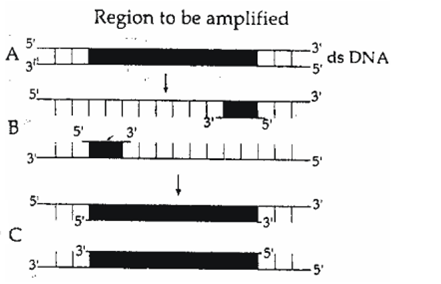 Multiple Choice Questions
Multiple Choice QuestionsWhich one of the following statements is correct with respect to immunity?
Preformed antibodies need to the injected to treat the bite by a viper snake
The antibodies against small pox pathogen are produced by T-lymphocytes
Antibodies are protein molecules, each of which has four light chains
Antibodies are protein molecules, each of which has four light chains
B.
The antibodies against small pox pathogen are produced by T-lymphocytes
In artificially acquired passive immunity performed antibody in an immune serum is introduced into the body by infection. As the antivenum used to treat snake bites. In this case, the body does not produce any antibodies. Antibody is a protein molecule having two light chain and two heavy chain. B-cells recognize and bind antigens and may differentiate to memory cell or plasma cells (produce antibody). T-cells casues transplant rejection.
The figure below shows three steps (A, B, C) of Polymerase Chain Reaction (PCR). Select the option giving correct identification together with what it represents?
B – Denaturation at a temperature of about 98°C separatiing the two DNA strands
A – Denaturation at a temperature of about 50°C
C – Extension in the presence of heat stable DNA polymerase
C – Extension in the presence of heat stable DNA polymerase
The first clinical gene therapy was given for treating
diabetes mellitus
chicken pox
rheumatoid arthritis
rheumatoid arthritis
Which one of the following represents a palindromic sequence in DNA?
5´ - GATACC - 3´
3´ - CCTAAG - 5
5´ - GAATTC - 3
3´ - CTTAAG - 5´
5´- CCAATG - 3´
3´ - GAATCC - 5´
5´- CCAATG - 3´
3´ - GAATCC - 5´
Which one of the following may require pollinators, but is genetically similar to autogamy?
Geitonogamy
Xenogamy
Apogamy
Apogamy
Which one of the following statements is not true?
Pollen grains are rich in nutrients, and they are used in the form of tablets and syrups
Pollen grains of some plants cause severe allergies and bronchial afflictions in some people
The flowers pollinated by flies and bats secrete foul odour to attract them
The flowers pollinated by flies and bats secrete foul odour to attract them
